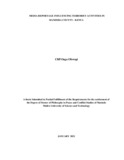| dc.description.abstract | Terrorism, often, has been used as a weapon by non-state actors like terrorist
organizations, liberation movements and other clandestine organizations fighting for
recognition and intending to advance different agenda. The aim of terrorism is to create
an audience to pressurize governments into ceding to terrorist demands because of fear.
Acts of terrorism by their nature easily endear themselves to extensive media coverage.
In Mandera County, terrorist activities have become so prevalent through the acts of
terrorism witnessed over the years and the intensity of their reporting makes it a unique
phenomenon that needs an academic interrogation. This makes the relationship between
terrorism and the media reportage in Mandera County very central to assess in relation
to anti-terrorism discourse and strategies. Media reportage is the independent variable
and terrorist activities is the dependent variable. This study sought to assess media
influence on terrorist activities in Mandera County. The specific objectives of the study
are to examine the media reportage on terrorism in Mandera County, to assess the effects
of media reportage on terrorist activities in Mandera County and to assess the challenges
the media faces in reportage of terrorist activities in Mandera County. This study
adopted a descriptive survey research design. The study was underpinned by two
theories namely: the agenda setting theory and the Liberalism theory. The Study
population constituted: Mandera County Officials, Local/International Media in
Mandera County, FBOs, CBOs, NGOs, KDF, NPS, NIS personnel and Local
Population/Al-Shabaab returnees/Chiefs/Clan Elders. The study used purposive
sampling technique in acquiring data from various institutions/departments where the
researcher chose specific people within the population to use for this particular study.
The study used mix methods whereby both primary and secondary data were collected.
The research instrument for primary data collection in this study was questionnaires.
Secondary data was collected through FGDs and key informant interviews. Once data
was collected, it was analyzed and presented in the form of graphs, charts and
descriptive narratives. A pilot study was conducted to test the validity of research
instruments. The study also made use of Supervisors and MMUST Research experts to
ensure validity of the research instruments. The findings of the study endeavor to
provide new knowledge while adding to the existing body of knowledge and inform
academia. The findings also help to inform the drafting of new policies and guidelines
and the re-drafting of existing policies regarding to the broadcast of terrorism activities.
The study found out that terrorism reports were aired mostly in radio stations which
were the most preferred media category. These reports were aired in form of news,
editorial analyses, interviews, expert commentaries and listener engagement calls. The
source of information for the media being journalists’ own observation and judgment led
to media reportage portraying terrorists as heroes and being strong. It was also
established that most of the media broadcasts relating to terrorism journalism were war
or violence oriented and to a greater extent, media content opposed efforts aimed at
fighting terrorism. The resultant effects included the media propelling the terrorists’
agenda through their content and delivery. The study finally noted that there were
challenges faced by the media in their reportage of terrorism. These challenges limited
their ability and capacity to objectively and accurately report on terrorism. The study’s
overall conclusion is that, the media supply oxygen to terrorists through the sustained
extensive and intensive coverage that they accord them hence the terrorists’ motivation
to plan and execute more terrorist activities. | en_US |

